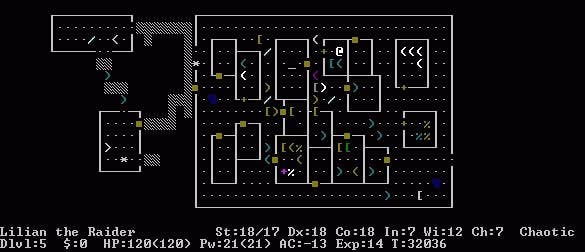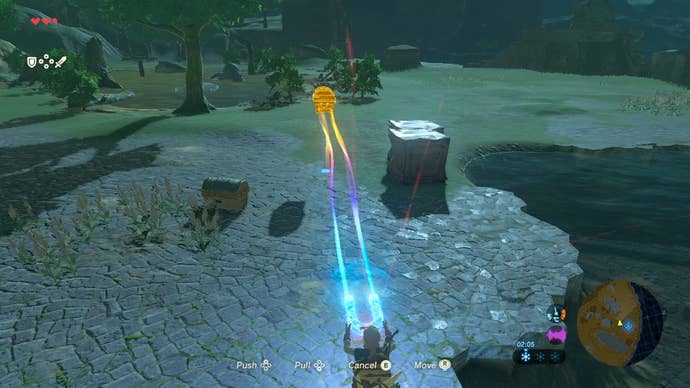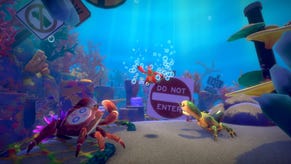The Top 25 RPGs of All Time #23: NetHack
Where are we "@" on our list? One of the most deceptively simple yet influential dungeon crawls.
This article first appeared on USgamer, a partner publication of VG247. Some content, such as this article, has been migrated to VG247 for posterity after USgamer's closure - but it has not been edited or further vetted by the VG247 team.
Imagine a world where nearly anything can happen. A monster can freeze you in your tracks with a mere glance, leaving you vulnerable for another creature to kill you. You can splatter oil on the ground and set it afire to lure enemies into a trap, but be careful: You're just as flammable. Rocks and other heavy objects can crush you. Lightning blasts can be directed at your foes, or backfire and fry you. Ponies can trample you. Falls can kill you. Giants will step on you.
This world is open-ended, arguably the most open-ended world ever. If you were born and raised in an era of graphics and physics engines, you'd be forgiven for believing such superlatives referred to 2017's The Legend of Zelda: Breath of the Wild. But for as open as Nintendo's adventure opus is, it pales in comparison to a much older game with a much simpler veneer.
NetHack rose to prominence by standing on the shoulders of giants. First came Rogue, a dungeon crawler written in 1980 by Glenn Wichman and Michael Toy. Both enjoyed playing text adventures but tired of them upon realizing their puzzles could only ever be fresh once. They endeavored to design a game with endless replayability. Toy and Wichman—joined later by Ken Arnold—wrote algorithms to construct dungeons, monsters, and items from text characters: alphanumeric symbols representing friends, foes, walls, floor tiles, doors, and loot. Thanks to algorithms that whipped up levels from scratch every time they played, not even Rogue's authors knew what they would find down in the dark.
After a group of industrious high school students discovered Rogue, they wrote Hack, a from-the-ground-up homage that added more items, monsters, and features. Hack made the rounds over military and university networks until it caught the attention of Mike Stephenson, a programmer who rolled out updates in his spare time. Stephenson distributed his game over Usenet and built a following of devoted players who asked if they could pitch in. Dubbing themselves the "DevTeam," the cohort--many of whom have never met--christened their game NetHack, a portmanteau that paid tribute to its roots as well as its distribution over Usenet. It's still being updated as recently as 2016.
Combat unfolds over turns, and every movement—letters and numbers scooting around the screen—is spelled out for you through succinct sentences: The goblin hits. The yeti bites. Your movements are now unencumbered.
Don't be fooled by NetHack's rudimentary interface. The absence of pixels and polygons works in its favor. Graphical games are limited by resources, namely money and time. 3D models are expensive. Even the most cutting-edge games can have slipshod animations and creepy models that drop you into the deepest depths of the uncanny valley, but not NetHack. There are more than 20,000 ways to die, from the heroic ("Killed by a black dragon") and mortifying ("Killed by a little dog") to the downright outrageous ("choked on a drawbridge") and literally petrifying ("petrified by wielding a cockatrice corpse bare-handed"). You can even slip and break your neck while mounting a horse.
Death is a big deal in NetHack. When you die, you leave behind a corpse and a headstone with an epitaph describing the manner of your death, and its fundamental rule of permadeath means that character cannot be resurrected for another shot at gaming glory. (Unless you're a save-scumming scumbag.)
But NetHack's open-endedness extends far beyond the tens of thousands of ways you can die. Consider the cockatrice, a mythical creature that resembles a hybrid dragon-rooster able to turn anything it touches to stone. You can make its cursed touch work in your favor by killing it from afar, slipping on a pair of gloves, picking it up, and wielding it like a club, petrifying anything it touches. (Just watch your step down any stairs while holding it.) Eels can yank you into bodies of water, drowning you. But as @ Play column author John Harris points out, there are myriad ways to fight back, such as peppering it with arrows from afar, or greasing your armor so the eel has trouble getting a grip, just to name two.

My allusions to The Legend of Zelda: Breath of the Wild before were not coincidental. While not an RPG by any conventional definition, Breath of the Wild is the first game I've played that felt almost as limitless and wondrous as NetHack. Almost. Without animations to render and expensive character models to produce, almost anything can happen, and almost anything can be done in NetHack, all rendered in—to borrow one of Zork's marketing taglines—the most sophisticated graphics engine ever conceived: Your imagination.
You may fall down a hole into a pack of high-level monsters and find your back up against a wall. Instead of going down swinging, dig through that wall to fashion an escape route. Not moving fast enough? Tame a wild pony to gallop away from danger. If you come upon a locked shop and are short on unlocking mechanisms, kick down the door and pay the shopkeeper for damages before he starts throwing fisticuffs, or kill him and appropriate his shop as your personal stash. You can even play a pacifist, killing monsters through indirect means such as siccing your pet on enemies and wearing rings of conflict to turn monsters against one another.
There is a goal in NetHack. Descend to the deepest level of the dungeon, recover the Amulet of Yendor, and take it to… uh, somewhere, and ascend to… godhood? I think? I have no idea, nor do I care. I've never beaten it, for two reasons. One, because it's hard. Really hard. NetHack veterans will tell you, with a mixture of pride and shame, that they've never ascended in 20-plus years of playing. Two, ascension really isn't the point. Ascension comes with bragging rights to be sure, but the real fun of NetHack is not in beating the game.
NetHack is about poking and prodding its intricate systems. It's about exploring its endless array of levels; of telling your friends the story of the time you found a Wand of Wishing and were granted silver dragon scale armor or discovered a staff with the hunger regeneration property just before you starved to death.

NetHack is about getting weird with character classes. Of forgoing the archetypical barbarian and wizard in favor of rolling a tourist, a character armed with a credit card and a camera. The tourist demonstrates that NetHack can be ye olde sword-and-sorcery yarn, but it can also be anachronistic and irreverent, in defiance of the droves of more stuffy and serious RPGs.
NetHack is about influence. Sure, its esoteric interface and punishing difficulty will scare away all but the most stalwart RPG fans, but its impact on RPGs, as well as the impact of roguelikes as a whole, cannot be denied. Diablo, FTL, Spelunky, The Binding of Isaac, Shovel Knight, and hundreds of other games, while not all strictly roguelikes, have borrowed and put a spin on genre mechanics such as permadeath and procedural content.
Those games, as great as they are, might be considered gateway drugs. Start with colorful graphics and click-heavy action. Then polish your shield of reflection, load film in your camera, and enter NetHack: deeper, darker, yet infinitely more complex and, in turn, infinitely more addictive.







.jpg?width=291&height=164&fit=crop&quality=80&format=jpg&auto=webp)
